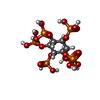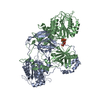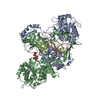+Search query
-Structure paper
| Title | Structural and functional basis of inositol hexaphosphate stimulation of NHEJ through stabilization of Ku-XLF interaction. |
|---|---|
| Journal, issue, pages | Nucleic Acids Res, Vol. 51, Issue 21, Page 11732-11747, Year 2023 |
| Publish date | Nov 27, 2023 |
 Authors Authors | Antonia Kefala Stavridi / Amandine Gontier / Vincent Morin / Philippe Frit / Virginie Ropars / Nadia Barboule / Carine Racca / Sagun Jonchhe / Michael J Morten / Jessica Andreani / Alexey Rak / Pierre Legrand / Alexa Bourand-Plantefol / Steven W Hardwick / Dimitri Y Chirgadze / Paul Davey / Taiana Maia De Oliveira / Eli Rothenberg / Sebastien Britton / Patrick Calsou / Tom L Blundell / Paloma F Varela / Amanda K Chaplin / Jean-Baptiste Charbonnier /    |
| PubMed Abstract | The classical Non-Homologous End Joining (c-NHEJ) pathway is the predominant process in mammals for repairing endogenous, accidental or programmed DNA Double-Strand Breaks. c-NHEJ is regulated by ...The classical Non-Homologous End Joining (c-NHEJ) pathway is the predominant process in mammals for repairing endogenous, accidental or programmed DNA Double-Strand Breaks. c-NHEJ is regulated by several accessory factors, post-translational modifications, endogenous chemical agents and metabolites. The metabolite inositol-hexaphosphate (IP6) stimulates c-NHEJ by interacting with the Ku70-Ku80 heterodimer (Ku). We report cryo-EM structures of apo- and DNA-bound Ku in complex with IP6, at 3.5 Å and 2.74 Å resolutions respectively, and an X-ray crystallography structure of a Ku in complex with DNA and IP6 at 3.7 Å. The Ku-IP6 interaction is mediated predominantly via salt bridges at the interface of the Ku70 and Ku80 subunits. This interaction is distant from the DNA, DNA-PKcs, APLF and PAXX binding sites and in close proximity to XLF binding site. Biophysical experiments show that IP6 binding increases the thermal stability of Ku by 2°C in a DNA-dependent manner, stabilizes Ku on DNA and enhances XLF affinity for Ku. In cells, selected mutagenesis of the IP6 binding pocket reduces both Ku accrual at damaged sites and XLF enrolment in the NHEJ complex, which translate into a lower end-joining efficiency. Thus, this study defines the molecular bases of the IP6 metabolite stimulatory effect on the c-NHEJ repair activity. |
 External links External links |  Nucleic Acids Res / Nucleic Acids Res /  PubMed:37870477 / PubMed:37870477 /  PubMed Central PubMed Central |
| Methods | EM (single particle) / X-ray diffraction |
| Resolution | 2.74 - 3.7 Å |
| Structure data | EMDB-14955, PDB-7zt6: EMDB-14986, PDB-7zvt:  PDB-7z6o: |
| Chemicals |  ChemComp-IHP: |
| Source |
|
 Keywords Keywords |  DNA BINDING PROTEIN / DNA BINDING PROTEIN /  DNA Repair; Double-Strand Break; NHEJ / DNA Repair; Double-Strand Break; NHEJ /  DNA repair / DNA repair /  NHEJ / Ku 70/80 / DNA-PK / NHEJ / Ku 70/80 / DNA-PK /  cancer / double-strand break / cancer / double-strand break /  Ku70 / Ku70 /  Ku80 / Ku80 /  DNA damage DNA damage |
 Movie
Movie Controller
Controller Structure viewers
Structure viewers About Yorodumi Papers
About Yorodumi Papers








